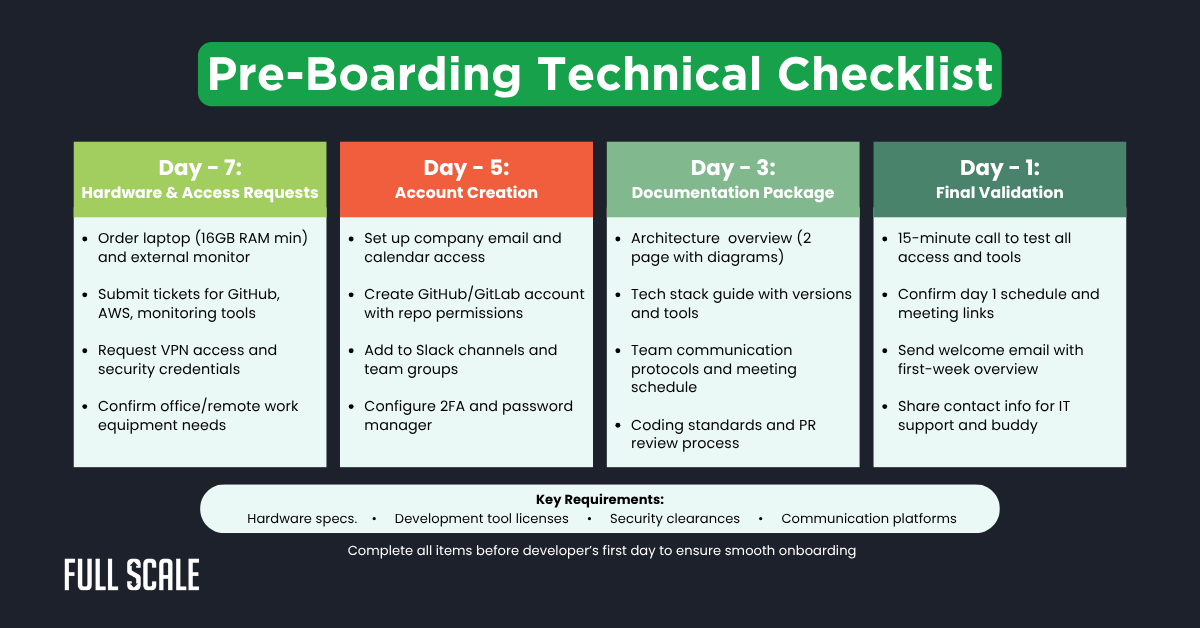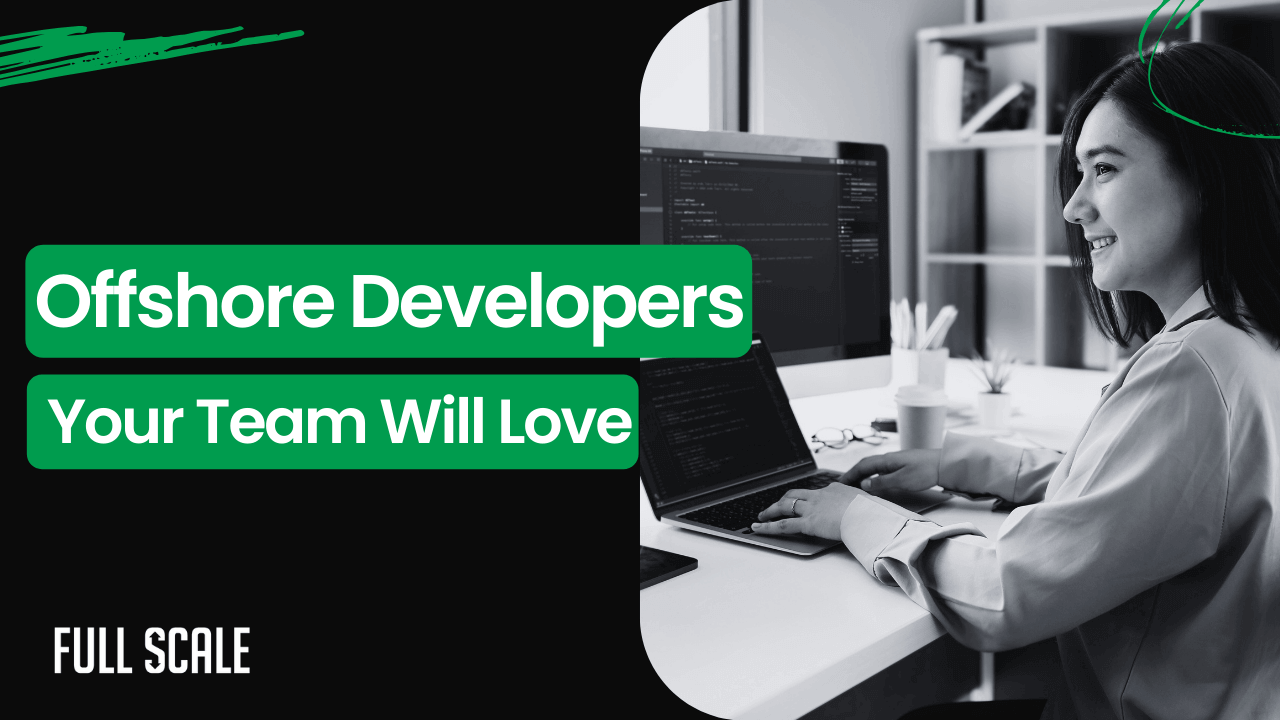Last Updated on 2025-08-26
Six weeks. That’s how long most companies take to onboard a single developer, costing over $75,000 in lost productivity. But implementing developer onboarding best practices can change everything—one of our clients reduced their onboarding from 6 weeks to just 10 days while improving code quality by 40%.
The secret lies in following structured developer onboarding best practices that transform how you integrate technical talent. This isn’t another generic checklist—it’s a proven framework that works for distributed teams across time zones.
The True Cost of Poor Developer Onboarding
Poor technical onboarding costs more than you think. According to a 2024 DevOps Institute study, developers produce negative value for their first three months without following developer onboarding best practices. That’s $240,000 in annual losses per mis-hired senior developer.
The hidden costs multiply fast when you ignore developer onboarding best practices. Senior developers lose 30% productivity mentoring new hires without clear protocols, while sprint velocity drops 25-40% when integrating new team members.
Developer Onboarding Cost Calculator
Developer Onboarding Cost Calculator
The 90-Day Protocol Overview
Effective developer onboarding best practices follow a clear progression through four phases. Each phase builds on the previous one, ensuring developers gain confidence while delivering value. Here’s how the 90-day onboarding plan transforms new hires into autonomous contributors.
Days 1-10: Foundation Sprint
- Environment setup and core system understanding
- First code commit by day three
- Establishing early momentum
Days 11-30: Integration Phase
- Pair programming rotations
- First feature ownership
- Remote developer onboarding collaboration
Days 31-60: Acceleration Phase
- Independent feature delivery
- Production deployment ownership
- 70% capacity contribution
Days 61-90: Autonomy Phase
- Full productivity achievement
- Complex feature leadership
- Mentoring other new hires
Pre-Boarding: The Forgotten Week
Smart developer onboarding best practices start before day one. Pre-boarding reduces first-week friction by 80%, according to research from Remote Work Association (2024). This preparation phase determines whether your new developer hits the ground running.
Technical Setup Checklist
Every developer needs specific tools ready before starting. Create a comprehensive technical onboarding checklist covering:
- Hardware specifications and software licenses
- VPN configuration and security requirements
- Development environment preferences
- Communication tool access
Pre-Boarding Technical Review

Documentation Package
Following developer onboarding best practices means providing essential documentation without overwhelming new hires. Focus on a two-page architecture overview, visual system diagrams, and team-specific glossaries. Include your tech stack map and communication protocols for a successful remote team onboarding.
Access Provisioning Timeline
Start access provisioning seven days before the start date. Order hardware on day 7, create accounts by day 5, and share documentation by day 3. Schedule a validation call on day 1 to confirm everything works properly.
Days 1-10: Foundation Sprint Implementation
The first ten days of following developer onboarding best practices determine your new developer’s trajectory. A structured developer onboarding process during this foundation sprint creates confidence and momentum.
Here’s the exact schedule that works for distributed development teams.
Day 1: Structured Start
Begin with a 30-minute welcome meeting at 9:00 AM sharp. Follow with IT setup validation, giving two hours for environment configuration. Schedule a codebase walkthrough with the tech lead before lunch, then assign a pre-selected bug fix.
End day one with a check-in addressing questions and concerns. This approach to developer onboarding best practices reduces first-day anxiety while establishing clear expectations.
Days 2-3: Architecture Deep Dive
Dedicate two hours daily to system architecture sessions covering:
- Microservices mapping and interactions
- Database schemas and relationships
- API documentation and endpoints
- Deployment pipelines and procedures
New developers must understand component interactions before writing code. This foundation prevents architectural mistakes that create technical debt later.
Days 4-5: Development Environment Mastery
Focus on local development setup, including Docker configuration and IDE optimization. Guide new hires through your testing framework and code quality tools. Assign a simple documentation fix as their first pull request to familiarize them with review processes.
Environment mastery represents crucial developer onboarding best practices. Developers who understand their tools deliver better code faster throughout the 90-day developer plan.
Days 6-10: Guided Coding
Implement daily two-hour pair programming sessions with senior developers. Focus on coding standards, review processes, and team conventions. The milestone: first feature contribution merged by day ten.
This intensive guidance accelerates learning through developer onboarding best practices. New hires gain confidence while senior developers share tribal knowledge effectively.
Days 11-30: Integration Phase Execution
Week three marks the transition from learning to contributing. The developer onboarding process now emphasizes practical application through real feature development. This phase proves especially critical for remote developer onboarding scenarios.
Week 3: Code Ownership
Assign a low-complexity, well-defined feature to each developer. Success metrics include:
- Pull request submitted within five days
- Review completion in less than three cycles
- Zero production issues
Feature ownership teaches responsibility through developer onboarding best practices. Developers learn quality standards through practical application rather than theoretical discussion.
Week 4: Cross-Team Exposure
Create rotation schedules exposing new hires to different teams:
- Frontend team: 2 days
- Backend team: 2 days
- DevOps session: 1 day
- Technical blog post summarizing learnings
Cross-team exposure breaks down silos within the engineering team onboarding. Developers understand the full system impacts of their code changes.
Remote Team Integration Tactics
Remote developer onboarding requires intentional communication structures. Implement morning standups with cameras required, afternoon pair programming slots, and end-of-day Slack summaries. Set clear response time expectations.
30-Day Developer Integration Dashboard
Overall Progress
Completed Day 3
Completed Day 8
Completed Day 15
In Progress
Day 25
Day 30
Week 4: Team Rotation Schedule
Frontend Team
Days 22-23
React, TypeScript, UI/UXBackend Team
Days 24-25
APIs, Databases, ServicesDevOps Team
Day 26
CI/CD, InfrastructureIntegration Timeline
Optimize time zone overlap between Southeast Asian and Western teams by scheduling critical meetings during shared hours. This approach to developer onboarding best practices ensures no one feels isolated during their crucial first month.
Days 31-60: Acceleration Metrics
Month two transforms assisted developers into independent contributors through proven developer onboarding best practices. Track specific metrics to ensure your investment in structured onboarding delivers returns. This phase separates average onboarding from exceptional developer integration.
Productivity Benchmarks
Set clear targets following developer onboarding best practices:
Weeks 5-6 Targets
- One medium-complexity feature completed
- Five or more code reviews given
- Zero rollbacks or hotfixes
Weeks 7-8 Targets
- Two features are managed in parallel
- Leading design discussions
- Mentoring newer hires
These benchmarks indicate growing competence within your development ecosystem. Track progress weekly to identify areas needing additional support.
Feedback Loop Implementation
Structure weekly one-on-ones into focused segments: fifteen minutes for technical progress, ten minutes for blockers, and five minutes for goals. This approach respects everyone’s time while maintaining a connection.
Implement monthly 360 reviews as part of developer onboarding best practices. Gather peer feedback from three developers, manager assessment, and self-evaluation comparison to accelerate growth during critical ramp-up periods.
Days 61-90: Achieving Autonomy
The final month of developer onboarding best practices establishes full productivity. Your 90-day onboarding plan culminates with developers contributing at capacity. This phase differentiates good onboarding from great developer integration processes.
Independent Contribution Metrics
Following developer onboarding best practices, expect:
- 3-4 story points per sprint
- 90% code review approval rate
- Production deployment privileges by day 75
These developer productivity metrics indicate readiness for complex challenges. Track numbers to validate your onboarding investment and identify top performers early.
Knowledge Sharing Requirements
Implementing developer onboarding best practices includes documentation contributions:
- Update two outdated documents
- Create a new guide
- Record one architecture video
This knowledge sharing reinforces learning while improving resources. New developers who teach others solidify their understanding, creating a self-reinforcing culture aligned with developer onboarding best practices.
Measuring Success: The Data That Matters
Track specific metrics throughout your implementation of developer onboarding best practices. According to Stack Overflow’s 2024 Developer Survey, companies with structured onboarding see 62% faster time-to-productivity. Here’s what matters most.
Time-to-Productivity Metrics
| Milestone | Target Day | Success Indicator |
| First Commit | Day 3 | Code passes CI/CD |
| First Feature | Day 15 | Merged to production |
| Independent Feature | Day 45 | No senior assistance |
| Team Velocity Neutral | Day 60 | Sprint points maintained |
| Net Positive | Day 90 | Above average contribution |
Quality and Retention Indicators
Developer onboarding best practices improve quality metrics: code review cycles under two days by day 30, bug rates below 5% by day 60, and test coverage above 90% by day 90. These ensure quality remains high during rapid integration.
Retention rates validate your developer onboarding best practices: 95% at 90 days and 87% at one year with this protocol. Industry averages sit at 80% and 65% respectively, proving the value of structured onboarding.
Implementation Roadmap for Your Team
Transform your current process using these developer onboarding best practices within four weeks. Start small, measure everything, and iterate based on data. Here’s your practical path forward.
Week 1: Protocol Customization
Adapt timelines to your tech stack and team structure. Create role-specific variations and define success metrics aligned with business goals.
Week 2: Resource Preparation
Build documentation libraries and assign onboarding buddies. Create feedback forms for tracking progress throughout the technical employee onboarding journey.
Week 3: Pilot Launch
Test with one or two developers initially. Track daily progress and hold weekly optimization meetings before scaling.
Week 4: Scale and Iterate
Roll out proven developer onboarding best practices to all new hires. Establish monthly reviews and quarterly analyses for continuous improvement.
Transform Your Developer Onboarding Today
The 90-day technical onboarding protocol exemplifies developer onboarding best practices that transform team integration. Companies implementing this approach reduce time-to-productivity by 70% while improving retention. The data proves what intuition suggests: better onboarding creates better developers.
Use our complete technical onboarding checklist to implement these developer onboarding best practices immediately. Audit your current process to identify gaps, then start with pre-boarding improvements for immediate impact.
90-Day Developer Onboarding Checklist
Complete Technical Onboarding Protocol
Pre-boarding (Day -7 to Day -1)
Days 1-10: Foundation Sprint
| Milestone | Target Day | Completed | Notes |
|---|---|---|---|
| First Commit | Day 3 | ||
| Dev Environment Ready | Day 5 | ||
| First PR Merged | Day 10 |
Days 11-30: Integration Phase
Integration Phase Notes
Days 31-60: Acceleration Phase
Days 61-90: Autonomy Phase
| Final Metrics | Target | Actual | Notes |
|---|---|---|---|
| Time to First Commit | Day 3 | ||
| Time to First Feature | Day 15 | ||
| Time to Independence | Day 45 | ||
| Code Review Approval Rate | 90% | ||
| Sprint Velocity | 3-4 points |
Final Assessment & Recommendations
Download or Print Your Checklist
Save this checklist for offline use or share with your team.
Let Full Scale Help Your Team Succeed
Ready to revolutionize your approach? Full Scale helps companies around the world customize developer onboarding best practices for their unique needs.
Book a consultation to discover how structured onboarding transforms engineering productivity and retention.
Stop losing money on slow developer ramp-up. Start building better teams with proven developer onboarding best practices today.
Build Your Development Team Today
FAQs: Developer Onboarding Best Practices
How long should developer onboarding best practices take to show results?
Following structured developer onboarding best practices shows results within 30 days. New developers submit code by day 3 and complete features by day 15. Companies report 70% faster time-to-productivity compared to unstructured approaches.
What’s the most critical phase in the technical onboarding checklist?
The pre-boarding phase (days -7 to 1) proves most critical in any technical onboarding checklist. This phase reduces day-one friction by 80% through proper access provisioning and documentation. For remote developer onboarding, days 11-30 determine long-term success.
How do we measure ROI for our 90-day onboarding plan?
Track time-to-productivity reduction and multiply by developer hourly rates. Most companies save $50,000-75,000 per developer. Additional metrics include 95% retention rates and 40% fewer code review cycles throughout the developer onboarding timeline.
Can this engineering onboarding framework work for distributed teams?
Yes, this engineering onboarding framework excels for distributed teams with proper adaptation. Add mandatory video calls, async communication protocols, and timezone-aware scheduling. Teams in the Philippines optimize overlap hours for effective onboarding of distributed developers.
What if our tech stack differs from typical developer onboarding best practices?
Developer onboarding best practices work for any tech stack. Customize documentation and technical content while maintaining the proven 90-day structure. The framework adapts to any technology while delivering consistent productivity improvements.

Matt Watson is a serial tech entrepreneur who has started four companies and had a nine-figure exit. He was the founder and CTO of VinSolutions, the #1 CRM software used in today’s automotive industry. He has over twenty years of experience working as a tech CTO and building cutting-edge SaaS solutions.
As the CEO of Full Scale, he has helped over 100 tech companies build their software services and development teams. Full Scale specializes in helping tech companies grow by augmenting their in-house teams with software development talent from the Philippines.
Matt hosts Startup Hustle, a top podcast about entrepreneurship with over 6 million downloads. He has a wealth of knowledge about startups and business from his personal experience and from interviewing hundreds of other entrepreneurs.




